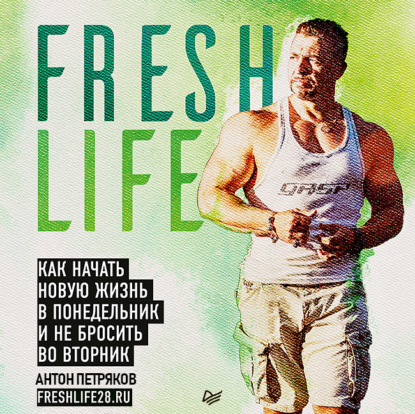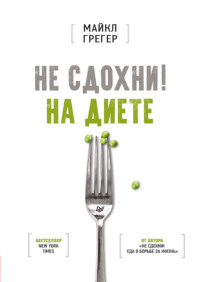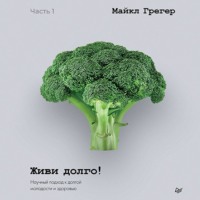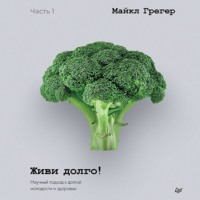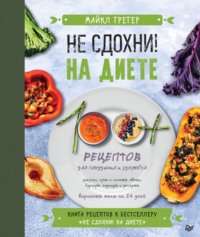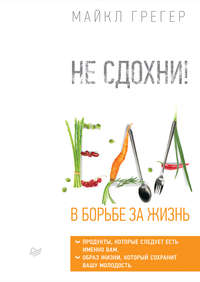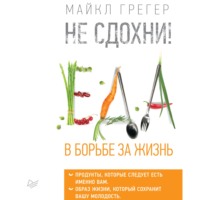
Полная версия
Живи долго! Научный подход к долгой молодости и здоровью
4145
Marjoribanks J, Farquhar CM, Roberts H, Lethaby A. Cochrane corner: long-term hormone therapy for perimenopausal and postmenopausal women. Heart. 2018;104(2):93–5. https://pubmed.ncbi.nlm.nih.gov/28739806/
4146
Pinkerton JV. Hormone therapy for postmenopausal women. N Engl J Med. 2020;382(5):446–5. https://pubmed.ncbi.nlm.nih.gov/31995690/
4147
Chew F, Wu X. Sources of information influencing the state-of-the-science gap in hormone replacement therapy usage. PLoS One. 2017;12(2):e0171189. https://pubmed.ncbi.nlm.nih.gov/28158240/
4148
Bhavnani BR, Stanczyk FZ. Pharmacology of conjugated equine estrogens: efficacy, safety and mechanism of action. J Steroid Biochem Mol Biol. 2014;142:16–29. https://pubmed.ncbi.nlm.nih.gov/24176763/
4149
ClinCalc DrugStats database. The top 300 of 2019. ClinCalc.com. https://clincalc.com/DrugStats/Top300Drugs.aspx. Updated September 12, 2021. Accessed May 5, 2022.; https://clincalc.com/DrugStats/Top300Drugs.aspx
4150
Kling J. The strange case of Premarin. Mod Drug Discov. 2000;3(8):46–52. https://pubsapp.acs.org/subscribe/archive/mdd/v03/i08/html/kling.html
4151
Pinkerton JV. Hormone therapy for postmenopausal women. N Engl J Med. 2020;382(5):446–5. https://pubmed.ncbi.nlm.nih.gov/31995690/
4152
ACOG Practice Bulletin No. 141: management of menopausal symptoms. Obstet Gynecol. 2014;123(1):202–16. https://pubmed.ncbi.nlm.nih.gov/24463691/
4153
Pinkerton JV. Hormone therapy for postmenopausal women. N Engl J Med. 2020;382(5):446–5. https://pubmed.ncbi.nlm.nih.gov/31995690/
4154
Brawley OW, O’Regan RM. Breast cancer screening: time for rational discourse. Cancer. 2014;120(18):2800–2. https://pubmed.ncbi.nlm.nih.gov/24925095/
4155
Biller-Andorno N, Jüni P. Abolishing mammography screening programs? A view from the Swiss Medical Board. N Engl J Med. 2014;370(21):1965–7. https://pubmed.ncbi.nlm.nih.gov/24738641/
4156
Nelson AL. Controversies regarding mammography, breast self-examination, and clinical breast examination. Obstet Gynecol Clin North Am. 2013;40(3):413–27. https://pubmed.ncbi.nlm.nih.gov/24021250/
4157
Loh KP, Stefan MS, Friderici J, et al. Healthcare professionals’ perceptions and knowledge of the USPSTF guidelines on breast self-examination. South Med J. 2015;108(8):459–62. https://pubmed.ncbi.nlm.nih.gov/26280768/
4158
Welch HG. Screening mammography – a long run for a short slide? N Engl J Med. 2010;363(13):1276–8. https://pubmed.ncbi.nlm.nih.gov/20860510/
4159
Gigerenzer G. Women’s perception of the benefit of breast cancer screening. Maturitas. 2010;67(1):5–6. https://pubmed.ncbi.nlm.nih.gov/20609537/
4160
Atkins CD. Potential hazards of mammography. J Clin Oncol. 2007;25(5):604. https://pubmed.ncbi.nlm.nih.gov/17290073/
4161
Barratt A. Overdiagnosis in mammography screening: a 45 year journey from shadowy idea to acknowledged reality. BMJ. 2015;350:h867. https://pubmed.ncbi.nlm.nih.gov/25736426/
4162
Gøtzsche PC, Jørgensen KJ, Zahl PH, Mæhlen J. Why mammography screening has not lived up to expectations from the randomised trials. Cancer Causes Control. 2012;23(1):15–21. https://pubmed.ncbi.nlm.nih.gov/22072221/
4163
Pace LE, Keating NL. A systematic assessment of benefits and risks to guide breast cancer screening decisions. JAMA. 2014;311(13):1327–35. https://pubmed.ncbi.nlm.nih.gov/24691608/
4164
Gøtzsche PC, Jørgensen KJ, Zahl PH, Mæhlen J. Why mammography screening has not lived up to expectations from the randomised trials. Cancer Causes Control. 2012;23(1):15–21. https://pubmed.ncbi.nlm.nih.gov/22072221/
4165
Sohn E. Screening: don’t look now. Nature. 2015;527(7578):S118–9. https://pubmed.ncbi.nlm.nih.gov/26580162/
4166
Gotzsche P. Commentary: screening: a seductive paradigm that has generally failed us. Int J Epidemiol. 2015;44(1):278–80. https://pubmed.ncbi.nlm.nih.gov/25596213/
4167
Derbyshire SWG. Second opinion: doctors, diseases and decisions in modern medicine. BMJ. 2003;327(7411):399. https://www.ncbi.nlm.nih.gov/pmc/articles/PMC1126826/
4168
Jørgensen KJ, Gøtzsche PC. The background review for the USPSTF recommendation on screening for breast cancer. Ann Intern Med. 2010;152(8):538; author reply 538–9. https://pubmed.ncbi.nlm.nih.gov/20157097/
4169
Domenighetti G, D’Avanzo B, Egger M, et al. Women’s perception of the benefits of mammography screening: population-based survey in four countries. Int J Epidemiol. 2003;32(5):816–21. https://pubmed.ncbi.nlm.nih.gov/14559757/
4170
Virani SS, Alonso A, Aparicio HJ, et al. Heart disease and stroke statistics—2021 update: a report from the American Heart Association. Circulation. 2021;143(8):e254–743. https://pubmed.ncbi.nlm.nih.gov/33501848/
4171
National Cancer Institute Surveillance, Epidemiology, and End Results Program. Cancer stat facts: female breast cancer. https://seer.cancer.gov/statfacts/html/breast.html. Accessed May 5, 2022.; https://seer.cancer.gov/statfacts/html/breast.html
4172
Parise CA, Caggiano V. Breast cancer survival defined by the ER/PR/HER2 subtypes and a surrogate classification according to tumor grade and immunohistochemical biomarkers. J Cancer Epidemiol. 2014;2014:469251. https://pubmed.ncbi.nlm.nih.gov/24955090/
4173
Romanos-Nanclares A, Willett WC, Rosner BA, et al. Healthful and unhealthful plant-based diets and risk of breast cancer in U.S. women: results from the Nurses’ Health Studies. Cancer Epidemiol Biomarkers Prev. 2021;30(10):1921–31. https://pubmed.ncbi.nlm.nih.gov/34289970/
4174
Link LB, Canchola AJ, Bernstein L, et al. Dietary patterns and breast cancer risk in the California Teachers Study cohort. Am J Clin Nutr. 2013;98(6):1524–32. https://pubmed.ncbi.nlm.nih.gov/24108781/
4175
Hankinson SE. Circulating levels of sex steroids and prolactin in premenopausal women and risk of breast cancer. In: Li JJ, Li SA, Mohla S, Rochefort H, Maudelonde T, eds. Hormonal Carcinogenesis V. Springer; 2008:161–9. https://pubmed.ncbi.nlm.nih.gov/18497040/
4176
Key T, Appleby P, Barnes I, et al. Endogenous sex hormones and breast cancer in postmenopausal women: reanalysis of nine prospective studies. J Natl Cancer Inst. 2002;94(8):606–16. https://pubmed.ncbi.nlm.nih.gov/11959894/
4177
Hankinson SE. Circulating levels of sex steroids and prolactin in premenopausal women and risk of breast cancer. In: Li JJ, Li SA, Mohla S, Rochefort H, Maudelonde T, eds. Hormonal Carcinogenesis V. Springer; 2008:161–9. https://pubmed.ncbi.nlm.nih.gov/18497040/
4178
Cleary MP, Grossmann ME. Minireview: obesity and breast cancer: the estrogen connection. Endocrinology. 2009;150(6):2537–42. https://pubmed.ncbi.nlm.nih.gov/19372199/
4179
Shultz TD, Leklem JE. Nutrient intake and hormonal status of premenopausal vegetarian Seventh-day Adventists and premenopausal nonvegetarians. Nutr Cancer. 1983;4(4):247–59. https://pubmed.ncbi.nlm.nih.gov/6224137/
4180
Barbosa JC, Shultz TD, Filley SJ, Nieman DC. The relationship among adiposity, diet, and hormone concentrations in vegetarian and nonvegetarian postmenopausal women. Am J Clin Nutr. 1990;51(5):798–803. https://pubmed.ncbi.nlm.nih.gov/2159209/
4181
Shultz TD, Howie BJ. In vitro binding of steroid hormones by natural and purified fibers. Nutr Cancer. 1986;8(2):141–7. https://pubmed.ncbi.nlm.nih.gov/3010251/
4182
Goldin BR, Woods MN, Spiegelman DL, et al. The effect of dietary fat and fiber on serum estrogen concentrations in premenopausal women under controlled dietary conditions. Cancer. 1994;74(3 Suppl):1125–31. https://pubmed.ncbi.nlm.nih.gov/8039147/
4183
Jew S, AbuMweis SS, Jones PJH. Evolution of the human diet: linking our ancestral diet to modern functional foods as a means of chronic disease prevention. J Med Food. 2009;12(5):925–34. https://pubmed.ncbi.nlm.nih.gov/19857053/
4184
Goldin BR, Adlercreutz H, Dwyer JT, Swenson L, Warram JH, Gorbach SL. Effect of diet on excretion of estrogens in pre- and postmenopausal women. Cancer Res. 1981;41(9 Pt 2):3771–3. https://pubmed.ncbi.nlm.nih.gov/7260944/
4185
Goldin BR, Adlercreutz H, Gorbach SL, et al. Estrogen excretion patterns and plasma levels in vegetarian and omnivorous women. N Engl J Med. 1982;307(25):1542–7. https://pubmed.ncbi.nlm.nih.gov/7144835/
4186
Beezhold B, Radnitz C, McGrath RE, Feldman A. Vegans report less bothersome vasomotor and physical menopausal symptoms than omnivores. Maturitas. 2018;112:12–7. https://pubmed.ncbi.nlm.nih.gov/29704911/
4187
Beezhold B, Radnitz C, McGrath RE, Feldman A. Vegans report less bothersome vasomotor and physical menopausal symptoms than omnivores. Maturitas. 2018;112:12–7. https://pubmed.ncbi.nlm.nih.gov/29704911/
4188
Noll PRES, Campos CAS, Leone C, et al. Dietary intake and menopausal symptoms in postmenopausal women: a systematic review. Climacteric. 2021;24(2):128–38. https://pubmed.ncbi.nlm.nih.gov/33112163/
4189
Cagnacci A, Cannoletta M, Palma F, Bellafronte M, Romani C, Palmieri B. Relation between oxidative stress and climacteric symptoms in early postmenopausal women. Climacteric. 2015;18(4):631–6. https://pubmed.ncbi.nlm.nih.gov/25536006/
4190
Aslani Z, Abshirini M, Heidari-Beni M, et al. Dietary inflammatory index and dietary energy density are associated with menopausal symptoms in postmenopausal women: a cross-sectional study. Menopause. 2020;27(5):568–78. https://pubmed.ncbi.nlm.nih.gov/32068687/
4191
Minkin MJ. Menopause: hormones, lifestyle, and optimizing aging. Obstet Gynecol Clin North Am. 2019;46(3):501–14. https://pubmed.ncbi.nlm.nih.gov/31378291/
4192
Woyka J. Consensus statement for non-hormonal-based treatments for menopausal symptoms. Post Reprod Health. 2017;23(2):71–5. https://pubmed.ncbi.nlm.nih.gov/28643614/
4193
Prentice RL, Howard BV, Van Horn L, et al. Nutritional epidemiology and the Women’s Health Initiative: a review. Am J Clin Nutr. 2021;113(5):1083–92. https://pubmed.ncbi.nlm.nih.gov/33876183/
4194
Patterson RE, Kristal A, Rodabough R, et al. Changes in food sources of dietary fat in response to an intensive low-fat dietary intervention: early results from the Women’s Health Initiative. J Am Diet Assoc. 2003;103(4):454–60. https://pubmed.ncbi.nlm.nih.gov/12669007/
4195
Patterson RE, Prentice RL, Beresford S, et al. Dietary adherence in the Women’s Health Initiative dietary modification trial. J Am Diet Assoc. 2004;104(4):654–8. https://pubmed.ncbi.nlm.nih.gov/15054353/
4196
Kroenke CH, Caan BJ, Stefanick ML, et al. Effects of a dietary intervention and weight change on vasomotor symptoms in the Women’s Health Initiative. Menopause. 2012;19(9):980–8. https://pubmed.ncbi.nlm.nih.gov/22781782/
4197
Rotolo O, Zinzi I, Veronese N, et al. Women in LOVe: lacto-ovo-vegetarian diet rich in omega-3 improves vasomotor symptoms in postmenopausal women. An exploratory randomized controlled trial. Endocr Metab Immune Disord Drug Targets. 2019;19(8):1232–9. https://pubmed.ncbi.nlm.nih.gov/31132980/
4198
Cetisli NE, Saruhan A, Kivcak B. The effects of flaxseed on menopausal symptoms and quality of life. Holist Nurs Pract. 2015;29(3):151–7. https://pubmed.ncbi.nlm.nih.gov/25882265/
4199
Messina M. Soy and health update: evaluation of the clinical and epidemiologic literature. Nutrients. 2016;8(12):E754. https://pubmed.ncbi.nlm.nih.gov/27886135/
4200
Thomas AJ, Ismail R, Taylor-Swanson L, et al. Effects of isoflavones and amino acid therapies for hot flashes and co-occurring symptoms during the menopausal transition and early postmenopause: a systematic review. Maturitas. 2014;78(4):263–76. https://pubmed.ncbi.nlm.nih.gov/24951101/
4201
Avis NE, Crawford SL, Greendale G, et al. Duration of menopausal vasomotor symptoms over the menopause transition. JAMA Intern Med. 2015;175(4):531–9. https://pubmed.ncbi.nlm.nih.gov/25686030/
4202
Avis NE, Kaufert PA, Lock M, McKinlay SM, Vass K. The evolution of menopausal symptoms. Baillieres Clin Endocrinol Metab. 1993;7(1):17–32. https://pubmed.ncbi.nlm.nih.gov/8435051/
4203
Thomas AJ, Ismail R, Taylor-Swanson L, et al. Effects of isoflavones and amino acid therapies for hot flashes and co-occurring symptoms during the menopausal transition and early postmenopause: a systematic review. Maturitas. 2014;78(4):263–76. https://pubmed.ncbi.nlm.nih.gov/24951101/
4204
Lock M. Contested meanings of the menopause. Lancet. 1991;337(8752):1270–2. https://pubmed.ncbi.nlm.nih.gov/1674073/
4205
Avis NE, Kaufert PA, Lock M, McKinlay SM, Vass K. The evolution of menopausal symptoms. Baillieres Clin Endocrinol Metab. 1993;7(1):17–32. https://pubmed.ncbi.nlm.nih.gov/8435051/
4206
Lock M. Contested meanings of the menopause. Lancet. 1991;337(8752):1270–2. https://pubmed.ncbi.nlm.nih.gov/1674073/
4207
Lock M. Ambiguities of aging: Japanese experience and perceptions of menopause. Cult Med Psychiatry. 1986;10(1):23–46. https://pubmed.ncbi.nlm.nih.gov/3486095/
4208
Avis NE, Stellato R, Crawford S, et al. Is there a menopausal syndrome? Menopausal status and symptoms across racial/ethnic groups. Soc Sci Med. 2001;52(3):345–56. https://pubmed.ncbi.nlm.nih.gov/11330770/
4209
Taku K, Melby MK, Kronenberg F, Kurzer MS, Messina M. Extracted or synthesized soybean isoflavones reduce menopausal hot flash frequency and severity: systematic review and meta-analysis of randomized controlled trials. Menopause. 2012;19(7):776–90. https://pubmed.ncbi.nlm.nih.gov/22433977/
4210
Ghazanfarpour M, Sadeghi R, Roudsari RL. The application of soy isoflavones for subjective symptoms and objective signs of vaginal atrophy in menopause: a systematic review of randomised controlled trials. J Obstet Gynaecol. 2016;36(2):160–71. https://pubmed.ncbi.nlm.nih.gov/26440219/
4211
Lambert MNT, Hu LM, Jeppesen PB. A systematic review and meta-analysis of the effects of isoflavone formulations against estrogen-deficient bone resorption in peri- and postmenopausal women. Am J Clin Nutr. 2017;106(3):801–11. https://pubmed.ncbi.nlm.nih.gov/28768649/
4212
Su BYW, Tung TH, Chien WH. Effects of phytoestrogens on depressive symptoms in climacteric women: a meta-analysis of randomized controlled trials. J Altern Complement Med. 2018;24(8):850–1. https://pubmed.ncbi.nlm.nih.gov/29717895/
4213
Cheng PF, Chen JJ, Zhou XY, et al. Do soy isoflavones improve cognitive function in postmenopausal women? A meta-analysis. Menopause. 2015;22(2):198–206. https://pubmed.ncbi.nlm.nih.gov/25003621/
4214
Schmidt M, Arjomand-Wölkart K, Birkhäuser MH, et al. Consensus: soy isoflavones as a first-line approach to the treatment of menopausal vasomotor complaints. Gynecol Endocrinol. 2016;32(6):427–30. https://pubmed.ncbi.nlm.nih.gov/26943176/
4215
Welty FK, Lee KS, Lew NS, Nasca M, Zhou JR. The association between soy nut consumption and decreased menopausal symptoms. J Womens Health (Larchmt). 2007;16(3):361–9. https://pubmed.ncbi.nlm.nih.gov/17439381/
4216
Barnard ND, Kahleova H, Holtz DN, et al. A dietary intervention for vasomotor symptoms of menopause: a randomized, controlled trial. Menopause. 2023;30(1):80–7. https://pubmed.ncbi.nlm.nih.gov/36253903/
4217
Barnard ND, Kahleova H, Holtz DN, et al. The Women’s Study for the Alleviation of Vasomotor Symptoms (WAVS): a randomized, controlled trial of a plant-based diet and whole soybeans for postmenopausal women. Menopause. 2021;28(10):1150–6. https://pubmed.ncbi.nlm.nih.gov/34260478/
4218
Buja A, Pierbon M, Lago L, Grotto G, Baldo V. Breast cancer primary prevention and diet: an umbrella review. Int J Environ Res Public Health. 2020;17(13):E4731. https://pubmed.ncbi.nlm.nih.gov/32630215/
4219
Messina M, Messina VL. Exploring the soyfood controversy. Nutr Today. 2013;48(2):68. https://www.researchgate.net/publication/271683198_Exploring_the_Soyfood_Controversy
4220
Nachvak SM, Moradi S, Anjom-Shoae J, et al. Soy, soy isoflavones, and protein intake in relation to mortality from all causes, cancers, and cardiovascular diseases: a systematic review and dose-response meta-analysis of prospective cohort studies. J Acad Nutr Diet. 2019;119(9):1483–1500.e17. https://pubmed.ncbi.nlm.nih.gov/31278047/
4221
Kelsey JL. A review of the epidemiology of human breast cancer. Epidemiol Rev. 1979;1:74–109. https://pubmed.ncbi.nlm.nih.gov/398270/
4222
Siegel RL, Miller KD, Fuchs HE, Jemal A. Cancer statistics, 2021. CA Cancer J Clin. 2021;71(1):7–33. https://pubmed.ncbi.nlm.nih.gov/33433946/
4223
Fraser GE, Jaceldo-Siegl K, Orlich M, Mashchak A, Sirirat R, Knutsen S. Dairy, soy, and risk of breast cancer: those confounded milks. Int J Epidemiol. 2020;49(5):1526–37. https://pubmed.ncbi.nlm.nih.gov/32095830/
4224
Shu XO, Zheng Y, Cai H, et al. Soy food intake and breast cancer survival. JAMA. 2009;302(22):2437–43. https://pubmed.ncbi.nlm.nih.gov/19996398/
4225
Guha N, Kwan ML, Quesenberry CP, Weltzien EK, Castillo AL, Caan BJ. Soy isoflavones and risk of cancer recurrence in a cohort of breast cancer survivors: the Life After Cancer Epidemiology study. Breast Cancer Res Treat. 2009;118(2):395–405. https://pubmed.ncbi.nlm.nih.gov/19221874/
4226
Kang X, Zhang Q, Wang S, Huang X, Jin S. Effect of soy isoflavones on breast cancer recurrence and death for patients receiving adjuvant endocrine therapy. CMAJ. 2010;182(17):1857–62. https://pubmed.ncbi.nlm.nih.gov/20956506/
4227
Rock CL, Doyle C, Demark-Wahnefried W, et al. Nutrition and physical activity guidelines for cancer survivors. CA Cancer J Clin. 2012;62(4):243–74. https://pubmed.ncbi.nlm.nih.gov/22539238/
4228
Caan BJ, Natarajan L, Parker B, et al. Soy food consumption and breast cancer prognosis. Cancer Epidemiol Biomarkers Prev. 2011;20(5):854–8. https://pubmed.ncbi.nlm.nih.gov/21357380/
4229
Zhang YF, Kang HB, Li BL, Zhang RM. Positive effects of soy isoflavone food on survival of breast cancer patients in China. Asian Pac J Cancer Prev. 2012;13(2):479–82. https://pubmed.ncbi.nlm.nih.gov/22524810/
4230
Chi F, Wu R, Zeng YC, Xing R, Liu Y, Xu ZG. Post-diagnosis soy food intake and breast cancer survival: a meta-analysis of cohort studies. Asian Pac J Cancer Prev. 2013;14(4):2407–12. https://pubmed.ncbi.nlm.nih.gov/23725149/
4231
Chi F, Wu R, Zeng YC, Xing R, Liu Y, Xu ZG. Post-diagnosis soy food intake and breast cancer survival: a meta-analysis of cohort studies. Asian Pac J Cancer Prev. 2013;14(4):2407–12. https://pubmed.ncbi.nlm.nih.gov/23725149/
4232
Kang HB, Zhang YF, Yang JD, Lu KL. Study on soy isoflavone consumption and risk of breast cancer and survival. Asian Pac J Cancer Prev. 2012;13(3):995–8. https://pubmed.ncbi.nlm.nih.gov/22631686/
4233
Buck K, Zaineddin AK, Vrieling A, Linseisen J, Chang-Claude J. Meta-analyses of lignans and enterolignans in relation to breast cancer risk. Am J Clin Nutr. 2010;92(1):141–53. https://pubmed.ncbi.nlm.nih.gov/20463043/
4234
McCann SE, Thompson LU, Nie J, et al. Dietary lignan intakes in relation to survival among women with breast cancer: the Western New York Exposures and Breast Cancer (WEB) Study. Breast Cancer Res Treat. 2010;122(1):229–35. https://pubmed.ncbi.nlm.nih.gov/20033482/
4235
Thompson LU, Chen JM, Li T, Strasser-Weippl K, Goss PE. Dietary flaxseed alters tumor biological markers in postmenopausal breast cancer. Clin Cancer Res. 2005;11(10):3828–35. https://pubmed.ncbi.nlm.nih.gov/15897583/
4236
Calado A, Neves PM, Santos T, Ravasco P. The effect of flaxseed in breast cancer: a literature review. Front Nutr. 2018;5:4. https://pubmed.ncbi.nlm.nih.gov/29468163/
4237
Hadi A, Askarpour M, Salamat S, Ghaedi E, Symonds ME, Miraghajani M. Effect of flaxseed supplementation on lipid profile: an updated systematic review and dose-response meta-analysis of sixty-two randomized controlled trials. Pharmacol Res. 2020;152:104622. https://pubmed.ncbi.nlm.nih.gov/31899314/
4238
Khandouzi N, Zahedmehr A, Mohammadzadeh A, Sanati HR, Nasrollahzadeh J. Effect of flaxseed consumption on flow-mediated dilation and inflammatory biomarkers in patients with coronary artery disease: a randomized controlled trial. Eur J Clin Nutr. 2019;73(2):258–65. https://pubmed.ncbi.nlm.nih.gov/30127374/
4239
Ursoniu S, Sahebkar A, Andrica F, et al. Effects of flaxseed supplements on blood pressure: a systematic review and meta-analysis of controlled clinical trial. Clin Nutr. 2016;35(3):615–25. https://pubmed.ncbi.nlm.nih.gov/26071633/
4240
Khandouzi N, Zahedmehr A, Mohammadzadeh A, Sanati HR, Nasrollahzadeh J. Effect of flaxseed consumption on flow-mediated dilation and inflammatory biomarkers in patients with coronary artery disease: a randomized controlled trial. Eur J Clin Nutr. 2019;73(2):258–65. https://pubmed.ncbi.nlm.nih.gov/30127374/
4241
Hadi A, Askarpour M, Ziaei R, Venkatakrishnan K, Ghaedi E, Ghavami A. Impact of flaxseed supplementation on plasma lipoprotein(A) concentrations: a systematic review and meta-analysis of randomized controlled trials. Phytother Res. 2020;34(7):1599–608. https://pubmed.ncbi.nlm.nih.gov/32073724/
4242
Almehmadi A, Lightowler H, Chohan M, Clegg ME. The effect of a split portion of flaxseed on 24-h blood glucose response. Eur J Nutr. 2021;60(3):1363–73. https://pubmed.ncbi.nlm.nih.gov/32699911/
4243
Ghazanfarpour M, Sadeghi R, Latifnejad Roudsari R, et al. Effects of flaxseed and Hypericum perforatum on hot flash, vaginal atrophy and estrogen-dependent cancers in menopausal women: a systematic review and meta-analysis. Avicenna J Phytomed. 2016;6(3):273–83. https://pubmed.ncbi.nlm.nih.gov/27462550/





